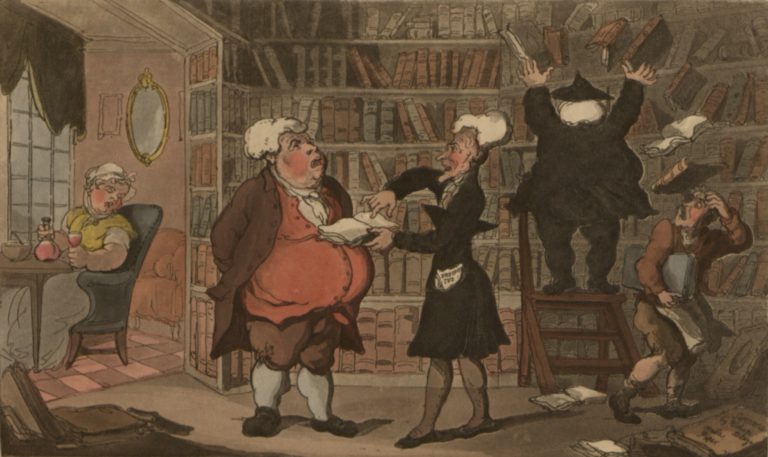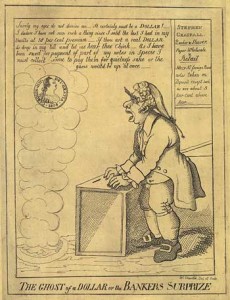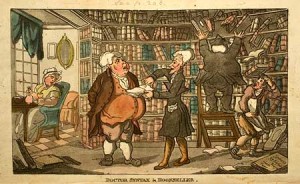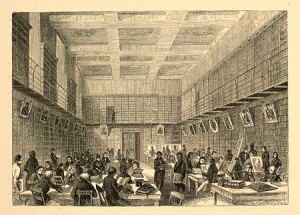The Other Panic of 1819

Irving’s Sketch Book, literary overproduction, and the politics of the “purely literary”
Most literary historians agree that the 1819 publication of Washington Irving’s collection of fiction and descriptive essays, The Sketch Book of Geoffrey Crayon, Gent., marks the beginning of professional authorship in the United States. For the first time, the imaginative work of an American writer appealed to a broad, relatively affluent reading audience and sustained for its author a long-term publishing career. But if the appearance of the Sketch Book marked the economic development of American literary culture, it was also haunted by widespread economic unrest. Written in the wake of the 1818 bankruptcy of P. and E. Irving, his brothers’ import company, the first issues of the Sketch Book were sent hastily to a waiting printer in order to stave off Washington Irving’s personal financial ruin. Irving had intended Moses Thomas to publish the American edition; but after Thomas nearly became insolvent in early 1819, Irving asked his friend, Henry Brevoort, to take over. A year later, the publisher of the English edition, John Miller, went bankrupt before the first volume was completed, leaving John Murray, London’s “prince of book sellers,” to finish the job. Of course, the wider context for so many failures was the widespread economic distress that troubled the Anglo-American world. In Britain, a severe recession followed the War of 1812 and the victory against Napoleon at Waterloo in 1815. In America, a series of bank failures led to the nation’s first financial crisis, the Panic of 1819.
The fact of Irving’s celebrated success and the tradition of classic American literature that it inaugurated make it easy to underestimate the impact of such economic turmoil on the social conditions of authorship. If domestic literary demand had become significant enough to encourage professional authors, however, it also required their dependence on both a highly competitive marketplace for books and readers whom they sometimes perceived as voracious, capricious, and vulgar. Writers like Irving saw themselves as disinterested gentlemen who wrote works of enduring cultural value, but their writing was often consumed by the same people who enjoyed cheaply produced books by less polite authors. Although the economic rewards of publishing enabled their writing, they took pains to deny their interest in financial remuneration. Yet their intimate relation to the risky, capital-driven business of publishing made them very much speculators on the tastes of a mass reading public, and even the most romantic of their writings often betray anxiety about this predicament. In some cases, this anxiety is expressed as a kind of panic about the status of authorship, literature, and books.
Compared with our own current economic recession, the cycle of boom and bust that led to the Panic of 1819 appears all too familiar. The economic expansion of the post-War period saw unprecedented growth in all aspects of American economic life: sharp increases in manufacturing and trade, the chartering of hundreds of new banks, near manic levels of investment, the entrance of many thousands of consumers into the middle class, and the expectation of an indefinite future of prosperity. This extraordinary growth, however, was facilitated by extremely easy credit and the over-production of currency, which by 1819 led to the collapse of America’s banking system and widespread economic depression characterized by glutted markets, falling prices and wages, large-scale capital losses, bankruptcy, unemployment, and an unprecedented number of citizens receiving poor relief (10 percent in New York City in 1820).
For many contemporary observers, the panic, whose effects lasted well into 1822, was a crisis of social stability, whereby the gothic specter of paper money and crushing debt signaled the demise of a land-based economy and a rank-based society and the arrival of a culture of indulgence and imposture (fig. 1). The Cincinnati Inquisitor Advertiser, for example, blamed the catastrophe on a “thirst for acquisition of riches without labor,” while the National Advocate complained of “loose and vulgar” young men who “plunge into the extravagance of the times,” such that “before they can earn a shilling by honest industry, they expend hundreds.” In the same vein, Niles’ Weekly Register expressed the hope that “honest men” would replace “speculating madman and visionary schemers,” and the Order of Tammany demanded a “fundamental change in morals and habits” and an end to “this factitious and preternatural accession of money.” Whatever their focus, most commentators emphasized the problem of an unstable currency. As William Tudor wrote in 1820, the “notion prevails, that a bank is to create wealth like a mine, and that the indefinite multiplication of engraven pieces of paper … is an actual increase of that property, though in reality it diminishes its value.”
If increasingly worthless paper money represented both a compromised social order and the compromised status of printed texts, it gave a certain aspect of perilous excess to the country’s rapidly expanding publishing industry and mass culture of reading. Since the 1790s, inexpensive sensationalist fiction had been available for purchase or through lending libraries in most American cities, and by 1800, urban printers were sending their wares (typically Bibles, devotional works, and cheap American editions of popular British authors) to rural markets across the ever-extending frontier. From 1810 to 1820, the total output of American presses grew by 50 percent; and by 1815, post-war affluence saw the emergence of well-stocked bookshops throughout the Atlantic seaboard and into the Ohio Valley. According to Mason Locke Weems, the influential southern book peddler, America in 1819 was “a Country of such boundless extent and rapidly growing population … where the passion of Reading is rising with a flood beyond all former notice of Man” (fig. 2).
Bookselling not only rose with the nation’s growing economy, its structure and business practices mirrored that of the unstable and illusory financial markets. The increasing availability of credit after the creation of the Bank of the United States in 1791 provided much of the capital necessary to print and sell books in what soon became a competitive and risky business. Although booksellers discovered various forms of cooperation to manage such risk in the short term, some of these had the long-term effect of merely disguising it. For example, they exchanged books with one another in order to diversify their offering and achieve better distribution. But because exchanges gave the false impression of actual sales, this practice quickly led to over-production and, despite rising sales, the inevitable devaluation of too many unsold books. Moreover, in order to raise capital and extend their credit over the long, unpredictable term of a book’s market life, they often endorsed or guaranteed each other’s promissory notes, in this way creating elaborate networks of mutual dependence. As a result, when one firm became insolvent, it often took several others down with it. But to make things even worse, many booksellers estimated their net worth based on unsold (and devalued) inventory rather than on a more realistic accounting of their assets. This meant that, at any given time, it was difficult for a bookseller to know either his own true financial position or that of the firms whose notes he’d endorsed. Thus, by 1819, with many thousands of worthless books circulating as inflated currency, the bankruptcy of a bookseller was a frequent occurrence.
Mathew Carey, the leading Philadelphia bookseller, lamented such problems in his 1813 Address to the Booksellers of America, and he blamed them chiefly on “delusive and pernicious speculations in extravagantly large editions.” Whereas London publishers typically printed small editions of 500 to 750, thereby keeping both demand and prices high, American publishers, in order to cover their higher production and distribution costs, often printed editions of 1,000 to 1,500. When such editions failed to find their audience, they were often sacrificed at book auctions or sold at “extravagant discounts.” But large editions also tied up booksellers’ capital, forcing them to borrow excessively and making them even more vulnerable to the “extreme fluctuations” of the market. As a result of such inefficiencies, a significant portion of booksellers’ assets lay “dormant,” much of it “not at present worth the price of the paper.” Indeed, Carey estimated that “two-thirds of the bankruptcies that have taken place among the booksellers, as well in Europe as in this country, have arisen from the immoderate extent of their editions.”
Yet overly large editions merely exacerbated what many American writers during the years surrounding the panic saw as the problem of too many authors. For some, such excess reflected a lack of originality. Edward Tyrell Channing’s 1816 essay, “On Models in Literature,” cautioned that if the enormous number of “borrowers and imitators are only encouraged, the swarm will go on thickening.” Others complained that intense competition made literary fame impossible. According to Richard Henry Dana’s 1821 Idle Man, “[B]ooks are multiplying so fast upon us, that they seem, at first sight, to be doing little else than crowding each other out of place.” Still others saw overproduction as symptomatic of a pandering, superficial literary culture. In his 1819 satirical poem, American Bards, Gorham Worth lamented the “contemptible catch-penny quackery” of the “glorious copartnership of Critics, Bards & Booksellers,” singling out for criticism the dubious practices of producing unnecessary second editions and “puffing” or promoting low-quality writing. In fact, Worth saw an explicit connection between such “inflations of folly” and those of America’s over-extended financial markets. “Let the old world compare with the new, if it can – / ‘Tis in vain! for America now leads the van, / And in bards, as in bankers, excels!”
The period’s most explicit fears of literary overproduction, however, were articulated in Irving’s Sketch Book. In one sketch, “The Art of Book Making,” Geoffrey Crayon’s musings on the “extreme fecundity of the press, and how it comes to pass that so many heads, on which nature seemed to have inflicted the curse of barrenness, should teem with voluminous productions” lead him to conjure a phantasmagoric scene of dispossession and revenge. Having wandered into the reading room of the British Museum library, he discovers “many pale, studious personages, poring intently over dusty volumes, rummaging among mouldy manuscripts, and taking copious notes of their contents.” These, he gradually discovers, “were principally authors and in the very act of manufacturing books” (fig. 3). But after musing on the ethics of literary borrowing, he falls asleep and dreams that these authors are “a ragged, thread bare throng” of untutored bumpkins, borrowing the “garments” of classic writers in a ridiculous display of “vulgar elegance” (fig. 4). The victims of this literary rapine, a cadre of long-dead authors arrayed in dour portraits on the library walls, then come to life and rise up in a fierce counterrevolution “to claim their rifled property” and chase the plunderers out of the library. Although, like Channing, Irving frames the sketch as a statement about literary originality, as a “getter up of miscellaneous works” himself and well accustomed to borrowing from classic authors, he appears to stage the imagined revolt of the portraits as an unconscious panic about literary overproduction and authorial dispossession.
In another sketch, “The Mutability of Literature,” Crayon has an imaginary “colloquy” with a dusty antique volume in Westminster Abbey about the morbid effects of time and social change on books, language, and literary reputation. At first, Crayon calls such mutability “the wise Precaution of Providence” to prevent “the creative powers of genius” from “overstock[ing] the world” and leaving the mind “completely bewildered in … endless mazes of literature.” But when he considers that in the modern age all former “restraints on this excessive multiplication” have vanished, he succumbs to a panic about overproduction and competition. The “inventions of paper and press,” he warns, “have made everyone a writer, and enabled every mind to pour itself into print, and diffuse itself over the whole intellectual world. The consequences are alarming. The stream of literature has swoln into a torrent—augmented into a river—expanded into a sea … Unless some unforeseen mortality should break out among the progeny of the muse, now that she has become so prolific,” Crayon worries, “I tremble for posterity.”
We can better understand the anxiety about authorship expressed in these sketches if we consider that, as Irving wrote them, he trembled more for himself than for posterity. In 1816, while living with his brother-in-law in England, he wrote to Brevoort that he was too “harassed & hagridden by the cares & anxieties of business” to produce anything literary; and in 1818, after the family firm had failed, he warned that “a much longer continuance of such a situation would indeed be my ruin.” When that year Thomas proposed his “getting up an original work,” however, Irving confessed he was “very squeamish on that point.” Desperate for money and capable of earning it only through his writing, he was nonetheless uncomfortable with the ungentlemanly idea of writing for money. “Whatever my literary reputation may be worth, it is very dear to me, and I cannot bring myself to risk it by making up books for mere profit.”
To write for “mere profit” was, for Irving, an unpleasant necessity. Born into New York’s commercial class, he had long mixed with his social betters and used his literary talents to claim a genteel place among them (fig. 5). But while he enjoyed the limited provincial success of his earlier works, Salmagundi and The History of New York, he was somewhat reluctant to participate in the increasingly unstable market for books and loathe to identify himself as anything but an amateur. Clinging to his gentlemanly status, he persistently declared that in publishing the Sketch Book he sought only a “scanty but sufficient means of support.” To “please the public and gain the good will of my countrymen,” he wrote, “is all I care about—I only want money enough to enable me to keep on my own way, and follow my own taste and inclination.” But in less guarded moments he made clear how important the financial success of this high-stakes venture was. “My fate hangs on it—for I am now at the end of my fortune.”
Irving’s apprehensions about money and status pervade the Sketch Book‘s themes of loss and nostalgia too. These are nowhere more apparent than in the sketch about “Roscoe,” a destitute banker and forgotten writer whose library is sold at auction to a crowd of “wreckers” and “speculators.” In a more abstract way, we also see them in the book’s melancholy stories of untimely death (“The Widow and Her Son,” “The Broken Heart,” and “The Pride of the Village”), of virtuous forbearance (“The Wife” and “The Royal Poet”), and of earlier, more stable times (“Rip Van Winkle,” “Rural Life in England,” and “The Legend of Sleepy Hollow”). As Irving attempts with each sketch to escape from what he called “the common-place realities of the present,” he betrays an uneasy yearning for traditional forms of culture in a rapidly changing world.
Perhaps the most ironic by-product of Irving’s authorial panic was his invocation of the idea of a pure form of literature, untainted by money, commerce, and changing tastes, one that would allow the public to distinguish the Sketch Book from what Dana snidely referred to as “the trashy works which are daily turned out.” In “The Mutability of Literature,” for example, after his fear subsides, Crayon admits that certain authors, such as Shakespeare, survive the chaos of overproduction. “Because they have rooted themselves in the unchanging principles of human nature,” they “transmit the pure light of poetical intelligence from age to age.” The “true poet” will survive the “increase of literature,” he insists, because he “writes from the heart and the heart will always understand him” (fig. 6). Likewise, in “Roscoe,” despite the author’s sad fate and the volatility of the market, the value of great books remains. “When all that is worldly turns to dross around us, these only retain their steady value.” In fact, reviewers of the Sketch Book said the same of it. Francis Jeffrey’s Edinburgh Review dubbed it the first “purely literary” American book worthy of praise, and in the North American Review Dana declared Irving the “first to begin and persevere in works which may be called ‘purely literary.'”
Such praise was doubly gratifying to Irving. It helped not only to distinguish him from more mercenary and less talented writers but also to generate record sales. But, in fact, the idea of the “purely literary,” which first gained widespread currency in the early nineteenth century, was only possible in the context of mass literary culture. For it was precisely the excesses of the bookselling industry that made cheap books readily available and that eventually produced Irving’s enthusiastic middle-class readership. Moreover, in spite of his protests, he was remarkably adept at the game he claimed to be so reluctant to play. He demanded and received a higher price for the first edition of the Sketch Book than even his mentor Walter Scott could command from London booksellers, and he insisted that the book be made of the finest paper, ink, and boards, thereby establishing a new industry standard of luxury. Indeed, it was Irving’s financial success, along with that of Scott, Byron, Cooper, and other best-selling writers, that finally made professional authorship respectable.
Like the blurred distinction between real wealth and paper profits, American authors of “purely literary” texts found it increasingly difficult after 1819 to distinguish their literary art from mere print commodities. Forever after, elite literary culture would be inextricably tied to popular culture, despite many protests to the contrary. But when genteel literary authorship first confronted the realities of capitalist commerce, such confusion was both novel and, for some, shocking. In other words, when writers like Irving first considered that the independence of aesthetics from economics might be merely a convenient fiction, panic ensued.
Further Reading:
On the early nineteenth-century transformation of American book publishing and reading culture, see James N. Green, “The Rise of Book Publishing in the United States, 1790-1840,” in Robert A. Gross and Mary Kelley, eds., A History of the Book in America: Volume 2: An Extensive Republic: Print, Culture, and Society in the New Nation, 1790-1840 (Chapel Hill, N.C, forthcoming); Rosalind Remer, Printers and Men of Capital: Philadelphia Book Publishing in the New Republic (Philadelphia, 1996); and Ronald J. Zboray, A Fictive People: Antebellum Economic Development and the American Reading Public (New York, 1993). A useful selection of relevant primary texts can be found in Scott E. Casper, Joanne D. Chaison, and Jeffrey D. Groves, eds., Perspectives on American Book History (Amherst, Mass., 2002). Although historical scholarship on the Panic of 1819 remains relatively thin, a technical overview is provided in Murray N. Rothbard, The Panic of 1819: Reactions and Policies (New York, 1962). For recent biographies of Irving, see Andrew Burstein, The Original Knickerbocker: The Life of Washington Irving (New York, 2006) and Brian Jay Jones, Washington Irving: An American Original (New York, 2008).
This article originally appeared in issue 9.3 (April, 2009).
Edward Cahill teaches American literature and culture at Fordham University in New York. He is completing a book on aesthetic theory and politics in the early republic.





